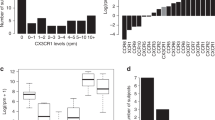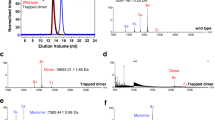Abstract
Chemokines are chemoattractant proteins that are divided into subfamilies based upon cysteine signature motifs termed C, CC, CXC and CX3C. Chemokines have roles in immunity and inflammation that affect cell trafficking and activation of T cells as well as cells of the innate immune system. We report here CX3C chemokine mimicry for the G glycoprotein of respiratory syncytial virus (RSV) and show binding to CX3CR1—the specific receptor for the CX3C chemokine fractalkine—and induction of leukocyte chemotaxis. We also show that CX3CR1 facilitates RSV infection of cells. Thus, G glycoprotein interaction with CX3CR1 probably plays a key role in the biology of RSV infection.
This is a preview of subscription content, access via your institution
Access options
Subscribe to this journal
Receive 12 print issues and online access
$209.00 per year
only $17.42 per issue
Buy this article
- Purchase on Springer Link
- Instant access to full article PDF
Prices may be subject to local taxes which are calculated during checkout




Similar content being viewed by others
Accession codes
References
Chanock, R. M., Parrott, R. H., Connors, M., Collins, P. L. & Murphy, B. R. Serious respiratory tract disease caused by respiratory syncytial virus: prospects for improved therapy and effective immunization. Pediatrics 90, 137–143 (1992).
Fixler, D. E. Respiratory syncytial virus infection in children with congenital heart disease: a review. Ped. Cardiol. 17, 163–168 (1996).
McIntosh, K. & Fishaut, J. M. Immunopathologic mechanisms in lower respiratory tract disease of infants due to respiratory syncytial virus. Prog. Med. Virol. 26, 94–118 (1980).
Hall, C. B. Respiratory syncytial virus: A continuing culprit and conundrum. J. Ped. 135, 2–7 (1999).
Chin, J., Magoffin, R. L., Shearer, L. A., Schieble, J. H. & Lennette, E. H. Field evaluation of a respiratory syncytial virus vaccine and a trivalent parainfluenza virus vaccine in a pediatric population. Am. J. Epidemiol. 89, 449–463 (1969).
Weibel, R. E., Stokes, J. Jr, Leagus, M. B., Mascoli, C. C. & Hilleman, M. R. Respiratory virus vaccines. V. Field evaluation for efficacy of heptavalent vaccine. Am. Rev. Resp. Dis. 94, 362–379 (1966).
Connors, M., Collins, P. L., Firestone, C.-Y. & Murphy, B. R. Respiratory syncytial virus (RSV) F, G, M2 (22K), and N proteins each induce resistance to RSV challenge, but resistance induced by M2 and N proteins is relatively short-lived. J. Virol. 65, 1634–1637 (1991).
Stott, E. J. et al. Immune and histopathological responses in animals vaccinated with recombinant vaccinia viruses that express individual genes of human respiratory syncytial virus. J. Virol. 61, 3855–3861 (1987).
Groothuis, J. R., King, S. J., Hogerman, D. A., Paradiso, P. R. & Simoes, E. A. Safety and immunogenicity of a purified F protein respiratory syncytial virus (PFP-2) vaccine in seropositive children with bronchopulmonary dysplasia. J. Infect. Dis. 177, 467–469 (1998).
Olmsted, R. A. et al. Expression of the F glycoprotein of respiratory syncytial virus by a recombinant vaccinia virus: comparison of the individual contributions of the F and G glycoproteins to host immunity. Proc. Natl Acad. Sci. USA 83, 7462–7466 (1986).
Bright, H., Turnbull, T., Toms, G. L. & Scott, R. Comparison of the T helper cell response induced by respiratory syncytial virus and its fusion protein in BALB/c mice. Vaccine 13, 915–922 (1995).
Graham, B. S. et al. Priming immunization determines T helper cytokine mRNA expression patterns in lungs of mice challenged with respiratory syncytial virus. J. Immunol. 151, 2032–2040 (1993).
Srikiatkhachorn, A. & Braciale, T. J. Virus-specific memory and effector T lymphocytes exhibit different cytokine responses to antigens during experimental murine respiratory syncytial virus infection. J. Virol. 71, 678–685 (1997).
Kurt-Jones et al. Pattern recognition receptors TLR4 and CD14 mediate response to respiratory syncytial virus. Nature Immunol. 1, 398–401 (2000).
Openshaw, P. J. Immunity and immunopathology to respiratory syncytial virus. The mouse model. Am. J. Respir. Crit. Care Med. 152, 59–62 (1995).
Johnson, T. R. et al. Priming with secreted glycoprotein G of respiratory syncytial virus (RSV) augments interleukin-5 production and tissue eosinophilia after RSV challenge. J. Virol. 72, 2871–2880 (1998).
Hancock, G. E. et al. Generation of atypical pulmonary inflammatory responses in BALB/c mice after immunization with the native attachment (G) glycoprotein of respiratory syncytial virus. J. Virol. 70, 7783–7791 (1996).
Sparer, T. E. et al. Eliminating a region of respiratory syncytial virus attachment protein allows induction of protective immunity without vaccine-enhanced lung eosinophilia. J. Exp. Med. 187, 1921–1926 (1998).
Tebbey, P., Hagen, M. & Hancock, G. Atypical pulmonary eosinophilia is mediated by a specific amino acid sequence of the attachment (G) protein of respiratory syncytial virus. J. Exp. Med. 188, 1967–1972 (1998).
Tripp, R. A. et al. Respiratory syncytial virus (RSV) G and/or SH proteins alter Th1 cytokines, natural killer cells and neutrophils responding to pulmonary infection in BALB/c mice. J. Virol. 73, 7099–7107 (1999).
Tripp, R. A., Jones, L. & Anderson, L. J. Respiratory syncytial virus G and/or SH glycoproteins modify CC and CXC chemokine mRNA expression in the BALB/c mouse. J. Virol. 74, 6227–6229 (2000).
Feldman, S. A., Hendry, R. M. & Beeler, J. A. Identification of a linear heparin binding domain for human respiratory syncytial virus attachment glycoprotein G. J. Virol. 73, 6610–6617 (1999).
Witt, D. P. & Lander, A. D. Differential binding of chemokines to glycosaminoglycan subpopulations. Curr. Biol. 4, 394–400 (1994).
Driscoll, K. E. Macrophage inflammatory proteins: biology and role in pulmonary inflammation. Exp. Lung Res. 20, 473–490 (1994).
Lalani, A. S. et al. The purified myxoma virus γ interferon receptor homolog M-T7 interacts with the heparin-binding domains of chemokines. J. Virol. 71, 4356–4363 (1997).
Koopmann, W., Ediriwickrema, C. & Krangel, M. S. Structure and function of the glycosaminoglycan binding site of chemokine macrophage-inflammatory protein-1β. J. Immunol. 163, 2120–2127 (1999).
Johnson, P. R., Spriggs, M. K., Olmsted, R. A. & Collins, P. L. The G glycoprotein of human respiratory syncytial viruses of subgroups A and B: extensive sequence divergence between antigenically related proteins. Proc. Natl Acad. Sci. USA 84, 5625–5629 (1987).
Melero, J. A., Garcia-Barreno, B., Martinez, I., Pringle, C. R. & Cane, P. A. Antigenic structure, evolution and immunobiology of human respiratory syncytial virus attachment (G) protein. J. Gen. Virol. 75, 2411–2418 (1997).
McDermott, D. H. & Murphy, P. M. Chemokines and their receptors in infectious disease. Springer Sem. Immunopathol. 22, 393–415 (2000).
Loetscher, P., Moser, B. & Baggiolini, M. Chemokines and their receptors in lymphocyte trafficking and HIV infection. Adv. Immunol. 74, 127–180 (2000).
Beisser, P. S. et al. Human cytomegalovirus chemokine receptor gene US28 is transcribed in latently infected THP-1 monocytes. J. Virol. 75, 5949–5957.
Endres, M. J., Garlisi, C. G., Xiao, H., Shan, L. & Hendrick, J. A. The Kaposi's sarcoma-related herpesvirus (KHSV)-encoded chemokine vMIP-1 is a specific agonist for the CC chemokine receptor (CCR)8. J. Exp. Med. 189, 1993–1998 (1999).
Combadiere, C. et al. Identification of CX3CR1. A chemotactic receptor for the human CX3C chemokine fractalkine and a fusion coreceptor for HIV-1. J. Biol. Chem. 273, 23799–23804 (1998).
Anderson, L. J. et al. Antigenic characterization of respiratory syncytial virus strains with monoclonal antibodies. J. Infect. Dis. 15, 626–633 (1985).
Sullender, W. Antigenic analysis of chimeric and truncated G proteins of respiratory syncytial virus. Virology 209, 70–79 (1995).
Combadiere, C., Gao, J., Tiffany, H. L. & Murphy, P. M. Gene cloning, RNA distribution, and functional expression of mCX3CR1, a mouse chemotactic receptor for the CX3C chemokine fractalkine. Biol. Biophys. Res. Comm. 253, 728–732 (1998).
Bourgeois, C., Bour, J. B., Lidholt, K., Gauthray, C. & Pothier, P. Heparin-like structures on respiratory syncytial virus are involved in its infectivity in vitro. J. Virol. 72, 7221–7227 (1998).
Hallak, L. K., Collins, P. L., Knudson, W. & Peeples, M. E. Iduronic acid-containing glycosaminoglycans on target cells are required for efficient respiratory syncytial virus infection. Virology 271, 264–275 (2000).
Schall, T. Fractalkine–a strange attractor in the chemokine landscape. Immunol. Today 18, 147–152 (1997).
Fong, A. M. et al. Fractalkine and CX3CR1 mediate a novel mechanism of leukocyte capture, firm adhesion, and activation under physiologic flow. J. Exp. Med. 188, 1413–1419 (1998).
Pelchen-Matthews, A. et al. Chemokine receptor trafficking and viral replication. Immunol.Rev. 168, 33–49 (1999).
Karron, R. A. et al. Respiratory syncytial virus (RSV) SH and G proteins are not essential for viral replication in vitro: clinical evaluation and molecular characterization of a cold-passaged, attenuated RSV subgroup B mutant. Proc. Natl Acad. Sci. USA 94, 13961–1396 (1997).
Feldman, S. A., Audet, S. & Beeler, J. A. The fusion glycoprotein of human respiratory syncytial virus facilitates virus attachment and infectivity via an interaction with cellular heparin sulfate. J. Virol. 74, 6442–6447 (2000)
Roder, C., Krusat, T., Reimers, K. & Werchu, H. Purification of respiratory syncytial virus F and G proteins. J. Chromat. 737, 97–106 (2000).
Tripp, R. A., Moore, D., Winter, J. & Anderson, L. J. Respiratory syncytial virus infection and G and/or SH protein expression contribute to substance P, which mediates inflammation and enhanced pulmonary disease in BALB/c mice J. Virol. 74, 1614–1622 (2000).
Boyden, S. The chemotactic effect of mixtures of antibody and antigen on polymorphonuclear leukocytes. J. Exp. Med. 115, 453–466 (1962).
Acknowledgements
We thank D. Moore, L. Kirsch and J. DeYonker for help preparing reagents and technical support.
Author information
Authors and Affiliations
Corresponding author
Rights and permissions
About this article
Cite this article
Tripp, R., Jones, L., Haynes, L. et al. CX3C chemokine mimicry by respiratory syncytial virus G glycoprotein. Nat Immunol 2, 732–738 (2001). https://doi.org/10.1038/90675
Received:
Accepted:
Issue Date:
DOI: https://doi.org/10.1038/90675
This article is cited by
-
Monoclonal antibodies targeting sites in respiratory syncytial virus attachment G protein provide protection against RSV-A and RSV-B in mice
Nature Communications (2024)
-
The implication of infection with respiratory syncytial virus in pediatric recurrent wheezing and asthma: knowledge expanded post-COVID-19 era
European Journal of Clinical Microbiology & Infectious Diseases (2024)
-
RSV pre-fusion F protein enhances the G protein antibody and anti-infectious responses
npj Vaccines (2022)
-
Ephedrae Herba and Cinnamomi Cortex interactions with G glycoprotein inhibit respiratory syncytial virus infectivity
Communications Biology (2022)
-
Antibody development for preventing the human respiratory syncytial virus pathology
Molecular Medicine (2020)



